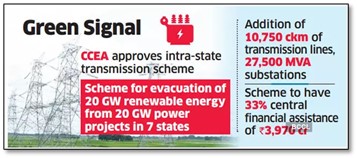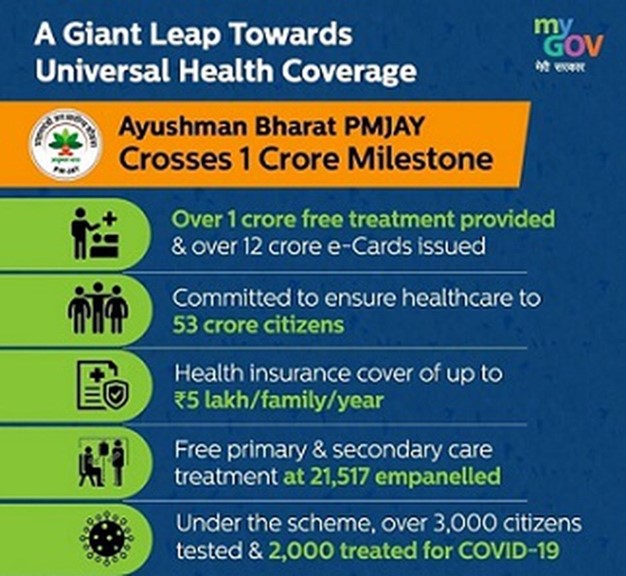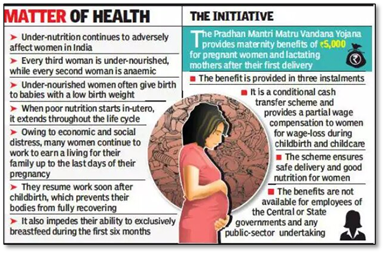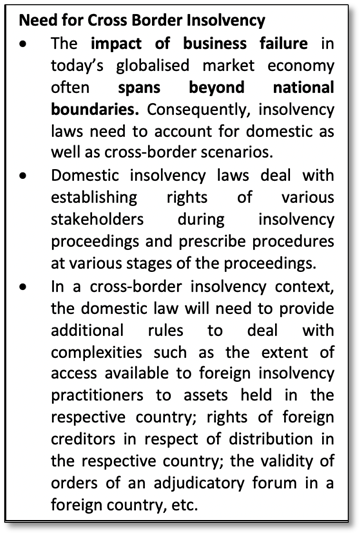Friday, 18th February 2022
Battery-as-a-service (BaaS)
In News
NITI Aayog would be holding consultation on electric vehicle (EV) battery swapping policy.
About the News
- With adoption of EVs, focus will shift towards development of infrastructure such as charging points and adopting battery swapping or the battery-as-a-service (BaaS) model .
- Budget 2022 has emphasized on participation of private players to develop sustainable and innovative business models for battery swapping or ‘Battery or Energy as a Service’.
- Currently, a Bengaluru-based startup is the first e-two-wheeler maker to sell its scooters with BaaS, and claims to have achieved a million battery swaps.
About the battery-as-a-service (BaaS) model/battery swapping
- Working: Battery swapping or Battery or Energy as a Service (BaaS) allows EV owners to replace the discharged batteries with charged ones at the swap stations. When the battery is discharged, the owner can change it with a fully charged
- Minimum infrastructure: It will help address the problem of setting up charging stations and also reduce range anxiety of drivers.
- Cost: It can help EV owners save the cost of purchasing a battery. Manufacturers can sell EVs in two forms: Vehicles with fixed or removable batteries and vehicles with batteries on lease. If you buy an electric scooter with battery leasing, you do not pay for the cost of the battery—that makes the initial acquisition almost 40% cheaper.
- Lesser-time: The service is less time consuming and takes only a few minutes compared to charging at a battery station which could take hours.
What are the major challenges?
- High cost: While the central government’s FAME-II schemes and various states’ EV policies have helped lower costs of EVs, particularly two-wheelers, the high cost of battery replacement and a lack of public charging infrastructure or dedicated home-charging spots in urban households have held back their mass adoption.
- Economic constraints: Energy service providers offering swapping solutions have to charge 18% goods and services tax (GST) for swapping, compared to 5% GST on the purchase of an EV. Additionally, the government’s FAME-II incentives are not offered to vehicles sold with BaaS or swap station operators.
- Operational constraints: lack of a dense and interoperable battery swap infrastructure has hindered the roll-out besides, manufacturers are keen to create proprietary battery and charging systems.
- Battery interoperability: manufacturer and service providers have safety concerns around the ‘one-size-fits-all’ model and caution too much standardization can kill innovation.
What can be done?
- Phased standardization: Swapping in the various permutations and combinations of batteries at a station should be in phased manner so that it could not lead to safety hazards.
- Incentives: Government can provide incentives over and above those given for buying clean vehicles of up to 20 percent on the subscription or lease cost of the battery for swapping usages.
- Promoting BaaS: government should encourage promotion of batteries-as-a-service (BaaS) to bring in efficiencies in the ecosystem.
- Batteries as service: If batteries are offered to customers as a ‘service’, much akin to refuelling a vehicle at a gas station, upfront costs can be significantly reduced, while addressing range anxieties.
- Robust battery swapping policy: government can formulate interoperability standards for charging to facilitate large-scale adoption of electric vehicles (EVs).
- Alternative use: There is a lot of (battery) capacity left at the end of first-use in electric vehicles, although these batteries may not be able to power vehicles any longer, they can be used for storing excess power generated by solar or wind farms.
Sources:
India’s Geospatial sector
In News
Deregulation of India’s Geospatial Sector completed one year recently.
What is Geospatial Sector?
- Geospatial Sector involves bodies involved in collecting, collating and disseminating data about objects, events, or phenomena that have a location on the surface of the earthk.a. geospatial data.
- The location may be static in the short-term, like the location of a road, an earthquake event, malnutrition among children, or dynamic like a moving vehicle or pedestrian, the spread of an infectious disease.
- Geospatial data combines location information, attribute information (the characteristics of the object, event, or phenomena concerned), and often also temporal information or the time at which the location and attributes exist.
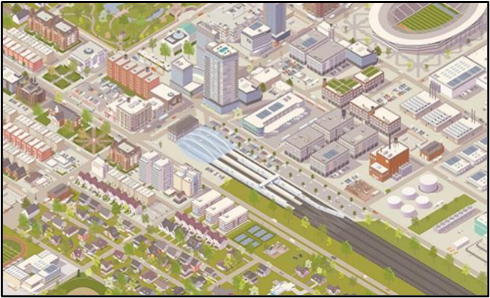
Current infrastructure
- Guidelines for Geospatial Data was launched a year ago that allowed Indian companies to operate without getting prior approvals, licences, or security clearances, in the Geospatial sector. Also, the data collected using public funds was made available to all Indian entities for economic, developmental as well as scientific purposes.
- India's geospatial economy is currently valued at Rs 38,972 crore and has potential to grow to Rs 63,100 crore at 12.8 per cent by 2025 end, according to India Geospatial Artha Report.
- The Centre is currently in the process of finalizing the draft National Geospatial Policy (NGP) and the Indian Satellite Navigation Policy (SATNAV Policy).
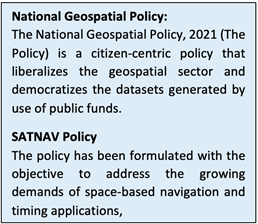
Issues with the sector
- Absence of a sizeable geospatial market in India on a scale linked to India’s potential and size. This is mainly due to the lack of awareness among potential users in government and private.
- Lack of skilled manpower across the entire pyramid of the geospatial sector from the providers to the users.
- Unavailability of foundation data, especially at high-resolution.
- There are still no ready-to-use solutions especially built to solve the problems of India.
Way Forward
- With the liberalisation of the sector, the first step towards development has been taken. This needs to be followed by aggressively and positively taking measures to make a leapfrog.
- The entire policy document of the Guidelines for Geospatial data needs to be published, and government and private users should be made aware of things related to it.
- The data available with government departments should be unlocked, and data sharing should be encouraged and facilitated. The culture of data sharing, collaboration and co-creation should be developed.
- The Government needs to invest in developing standards and must mandate the adoption of standards for an open data sharing protocol. There is a need to establish a geo-portal to make all public-funded data accessible through data as a service model, with no or nominal charge.
- To develop foundation data, Indian national digital elevation model (DEM) like Bhuvan DEM, data layers for cities, and data of natural resources may be utilized.
- A Digital Elevation Model (DEM) is a representation of the bare ground topographic surface of the Earth excluding trees, buildings etc.
- Local technology and solutions should be promoted, and competition should be encouraged for quality output.
- Government regulated bodies in the sector should be entrusted with the responsibility of regulation and the projects related to the nation’s security and scientific significance only.
- Academic programmes should be launched in Indian Institutes to fill the academic gap.
Sources:
- Zooming in on the potential of India’s geospatial sector:
- Explained: Why is India opening up the Geo-spatial sector? What impact will this have?:
- Indian geospatial market can grow at 12.8% to Rs 63,100 cr by 2025-Report:
- Revolutionary developments in mapping marks one year of Indian geospatial policy:
- SATNAV Policy – 2021: Effective development of India’s satellite navigation sector:
Rupee-denominated Green Bonds
In News
As a part of the government's overall borrowing programme, rupee-denominated green bonds will be issued to mobilise resources for green infrastructure.
About the News
- Issuing of rupee denominated Green bonds comes in the backdrop of India’s commitment to increase its share of external borrowing by not relying on the domestic markets to finance its infrastructure, and also fulfil its commitments as per India’s commitments as per COP 26.
- The sovereign green bonds will be issued as they will have long tenure to suit the requirement of green infrastructure projects and carry low risks as they are rupee denominated.
- The proceeds of this will be deployed in public sector projects that will help in reducing the carbon intensity of the economy.
- This will be part of the overall borrowing and the tenure would be normal like any G-sec tenure which is medium to long term but not short term.
- The borrowing will also be a purpose-oriented one and not a general-purpose borrowing.
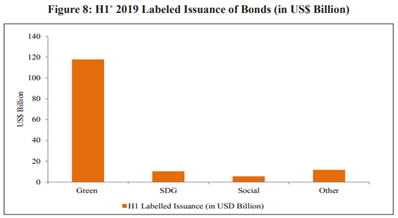
Understanding Green bonds
- Green bonds are debt securities issued by financial, non-financial or public entities where the proceeds are used to finance 100% green projects and assets.
- The first green bond was issued in 2007 by the European Investment Bank which is the EU’s lending arm followed by the World Bank in 2008.
- They are designated bonds intended to encourage sustainability and to support climate-related or other types of special environmental projects.
- They are aimed at energy efficiency, pollution prevention, sustainable agriculture, clean transportation, sustainable water management etc and also finance the cultivation of environmentally friendly technologies and mitigation of climate change.
- India has the second largest emerging green bond market after China.

Source:
- Green bonds to be rupee-denominated with long tenure: DEA secy
- Green bonds to be rupee-denominated with long tenure: DEA secretary
- Green bonds to have long tenure, says Centre
Image source:
Ramakrishna Paramhamsa
On February 18, 1836, Gadadhar Chattopadhyaya was better known as Ramakrishna Paramhamsa was born, in a small village near Kolkata, West Bengal, to a poor Brahmin family. The 19th-century monk was known for his compassion and devotion. He was also noted for his straightforward interpretations of Hindu philosophy, which drew him closer to his followers. He was an artist and a storyteller and an actor as a young man. Ramakrishna Paramahamsa was the one who influenced and moulded Swami Vivekananda's life. He was a forerunner of modern thinking in 19th century Bengal and was well-versed in religion and music. In 1866, he was ordained as a priest at a temple dedicated to the Goddess Kali near Kolkata on the Ganges River. Several rituals were performed throughout his tantric sadhana to aid in the purification of the mind and the cultivation of self-control. He practised 'Vamachara', 'Kumari-puja', and 'Kundalini yoga'. Later, he began practising the many 'Bhavas' listed in Vaishnava Bhakti, which were initiated by Lord Sri Chaitanya Mahaprabhu and Sri Nityananda Prabhu. In 1886, Ramakrishna died of throat cancer. Swami Vivekananda established the Ramakrishna Mission to spread his Guru's teachings.
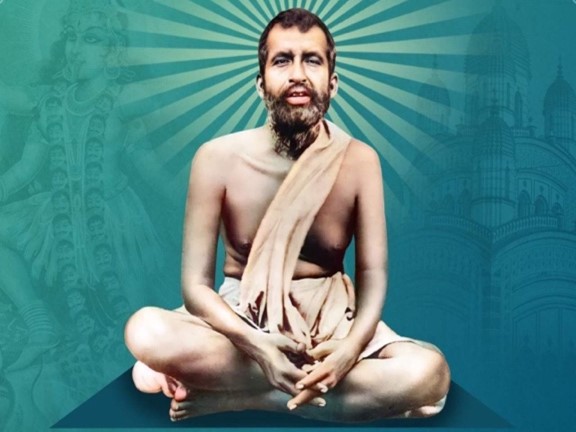
Source:
Budget 2022-23: Self Reliant in Defence
In News
The Union Budget 2022-23 has given further impetus to modernization of Defence Services and Defence Security Infrastructure development, including the Border Road Infrastructure and Coastal Security Infrastructure.
Budgetary Trends and Push to Self-Reliance in Defence
- The defence sector has remained an important focus for the government, cornering the largest share (13-14 percent) of budgetary allocation over the past few budgets.
- In 2022-23, the total Defence Budget including Defence Pensions has increased by 107.29% to Rs 25 lakh crore, from Rs 2.53 lakh crore in 2013-14.
- Through enhanced budgetary support over the years, the Government has placed modernization and infrastructure development of the Armed Forces at the centre stage of the National Security and Defence Planning process.
- The total allocation under Capital Outlay of the Defence Services has been increased from Rs 86,740 crore in 2013-14 to 1.52 lakh crore in 2022-23 (enhancement of 76%).
- Rising Capital Budget reflects the Government’s resolve towards sustainable enhancement in the modernisation and infrastructure development and also towards achieving the objectives of ‘Aatmanirbhar Bharat’.
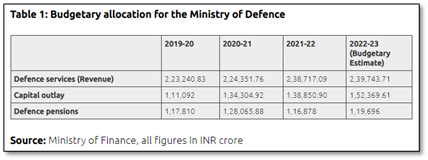
The Case for Self-Reliance in defence systems
- The global security environment has changed greatly since India’s Independence. Influence of cold war alignments in the sub-continental power balance, post cold war realignment of global power, emergence of a new super power in China, spread of nuclear weapons, role of non-state actors and asymmetric warfare have emerged as key issues in security threat perceptions.
- Globally, self-reliance in defence is the rule among developed nations (USA, UK, France, Germany etc.). Typically, permanent members of UNSC and other prominent members of EU limit their arms imports to be under 1% of their total imports.
- On the contrary India figures consistently among the top most arms importers.
- Self reliance is more than minimizing imports. It is a positive concept of promoting and enabling the national research, development and manufacturing sectors to fulfill their strategic mandate for major weapons and defence systems.
- It is also the method by which the resources unavoidably spent on acquisitions for security might be made to contribute to national industrial development and employment generation.
Current National Security Scenario and Urgent need for Self-reliant Defence
- Border stand-off with China: The Indian military will have to reinforce its presence in the region to ensure that the PLA doesn’t indulge in further adventurism on the Line of Actual Control.
- In Kashmir, there are indications that Pak-backed terrorist groups are likely to scale up their activities, with Taliban’s victory in Afghanistan acting as a catalyst. These dynamics have made it imperative that adequate financial resources are made available to secure India.
- There is also a background of ongoing military reforms and push for defence industrialisation.
- In October 2021, the government reorganized the Ordnance Factory Boards (OFB) into seven new defence public sector units. Now government is expecting to achieve efficiency in producing arms, ammunition, armoured vehicles, and clothing.
- Boost defence exports: The recent US $375 million deal to sell the Brahmos cruise missiles system to the Philippines has come as a much-needed shot in the arm for the Indian defence industry. The defence budget acquires significance in this context.
India's Pursuit of Self-Reliance in Defence Manufacturing and The Challenges Ahead
Recent measures to achieve self-reliance in defence manufacturing
- Import embargo on defence equipment: Ministry of Defence has notified ‘First Positive Indigenisation list’ of 101 items on 21stAugust 2020 and ‘2nd Positive Indigenisation list’ of 108 items on 31st May 2021 for which there would be an embargo on the import beyond the timelines indicated against them.
- Enhanced FDI: The Government of India has enhanced FDI in Defence Sector up to 74% through the Automatic Route for companies seeking new defence industrial license and up to 100% by Government Route wherever it is likely to result in access to modern technology.
- Capital procurement budget: For the year 2020-2021, the Ministry has created a separate budget head for domestic capital procurement and has allocated a budget of INR 52,000 crore for domestic procurement.
- Defence Acquisition Procedure 2020: DPP-2016 has been revised as Defence Acquisition Procedure (DAP) 2020, which is driven by the tenets of Defence Reforms announced as part of ‘Aatmanirbhar Bharat Abhiyan’.
- Defence Industrial Corridors: Government has established two Defence Industrial Corridors, one each in Uttar Pradesh and Tamil Nadu to attract investments of Rs 10,000 Cr in each corridor by year 2024-25.

Challenges to achieving self-reliance
- Lack of growth in defence modernisation and defence capabilities: This is mainly due to a (a) declining defence budget towards long term investments, and research and development; (b) process inefficiencies and delays in domestic production by government lead organizations; (c) and the government's reluctance to grant defence contracts to India's private sector.
- Budgetary issues: Despite increasing defence budget, a major chunk is spent on personnel costs such as salaries and pension, thereby shrinking the capital expenditure. Further, India's defence R&D budget at around 4% of the total defence budget for 2020-2021 is much lower than USA and China, which spend 12% and 20% of their defence budgets respectively.
- Lack of strategic planning for future needs of the Armed Forces: In the emerging geopolitical scenario, the Armed Forces' war-fighting capabilities have to be constantly augmented and technologically upgraded. This demands investments in long-term development of high-tech weapons.
- Production and time delays: For example, HAL took a total of 7 years to produce 16 Tejas aircrafts- India's first indigenously produced Light Combat Aircraft, despite estimated timeline of 4 years. According to a 2018 report by a parliamentary Committee on Estimates, the DRDO failed to meet timelines in all 14 mission projects for the Indian Air Force.
- Hierarchal and skewed decision-making: A 2018 internal report of the Ministry of Defence identified skewed decision-making process, bureaucratic red-tape and multiple decision-making heads as the reason for inordinate delays in defence procurement.
Conclusion: Between 2011–15 and 2016–20 arms imports by India decreased by 33%. This vindicates government’s consistent efforts towards self-reliant defence sector. However, challenges remain which needs urgent attention. With an assertive China on the continent and in the maritime sphere, malicious Pakistan, and an unstable Afghanistan, securing India’s security environment has become a complex endeavour. This budget, with a focus on achieving self-reliance in defence, builds on the achievements of recent years and charts a promising path ahead.
Question: The volatile internal and external security needs necessitate pragmatic self reliance in defence. Discuss in light of recent steps taken by the government in this direction.
Sources:
- Union Budget 2022-23
- Big Boost for Indigenous Development of Defence Systems in Budget 2022
- SELF-RELIANCE IN DEFENCE MANUFACTURING
- Defence budget 2022-23: Securing India, pursuing self-reliance
- Union Budget 2022: Defence goes big on self-reliance, TN set to fire on all cylinders
- Defence Budget 2022: Gearing up India’s domestic military-industrial complex
- Budget 2022 gives boost to domestic defence industry, 25% R&D budget earmarked for Indian companies
- India announces modest increase in defence budget with focus on self-reliance
- Budget 2022 | FM raises domestic defence procurement; invites private sector into military research
- India's Pursuit Of Self-Reliance In Defence Manufacturing And The Challenges Ahead
- Self-Reliance in Defence Sector
- Nation’s Long Term Vision Of Self Reliance In Defence Sector
- Opinion: Is self-reliance in Indian defence industry a distant dream?
- Self-reliance in defence production The unfinished agenda
- INDIAN DEFENCE INDUSTRY ISSUES OF SELF-RELIANCE
- Doctrine of Self Reliance in Defence Technologies: Road to Nowhere or Way to Go?
- “The Indigenisation of India’s Defence Industry”
- By Abhishek Verma, Partner—Aerospace and Defence, Infrastructure, Government and Healthcare (IGH), KPMG in India:
Trekker Saved
This image of the trekker trapped in a deep crevice on a steep hill in Kerala for more than 40 hours. He was rescued by the Indian army after two days of surviving without food or water. The trekker got trapped when he, along with his friends, went up the Kurumbachi hills in Cheradu, Palakkad. On their way down, he was exhausted and slipped on the rocks, ending up in a cavity in the hill. The trekker has allegedly trespassed the forest range, which comes under protected area.

Source:
Zombie firms
- Context: According to the RBI, zombie firms in India have been dampening the effectiveness of monetary policy.
- Zombie firms are companies that earn just enough money to continue operating and service their debt.
- They have no excess capital to spur growth and are considered close to insolvency.
- They are those firms that often survive longer than desirable, taking advantage of countercyclical policy support, thwarting the process of reallocation of resources from weak and vulnerable firms to strong firms having high growth potential.
- They are found to be highly leveraged; generate a negative return on assets over successive years and borrow more to survive rather than undertake new investment.
- In India, zombie firms are estimated to account for about 10% of total debt of the non-financial corporate sector. They have also absorbed about 10% of total bank credit extended to all firms in the economy.

Source:
- Zombie firms eating up bank resources: Study
- Zombie firms dampen effectiveness of monetary policy at margins: RBI study
Image source:
Genomics sequencing
- Context: India will be extending its SARS-CoV-2 Genomics Consortium (INSACOG) network of laboratories for genomic sequencing to the neighbouring countries to fight against COVID-19.
- INSACOG is a multi-laboratory, multi-agency, Pan-India network to monitor genomic variations in the SARS-CoV-2 by a sentinel sequencing effort.
- Genome sequencing is the process of determining the entirety of the DNA sequence of an organism's genomeat a single time which means sequencing all of an organism's chromosomal and mitochondrial DNA.
- Genomic sequencing has been very important for COVID-19 response.
- With the onset of new variants, genomic data will guide countries to make quick and informed public health decisions.
- It can help counties prepare for potential surges and take important steps such as increasing oxygen supply, opening more hospital beds or ramp up testing and to select the most appropriate vaccines to be used.
- Thus, India will take its experience in genomic sequencing, spread out in different geographies and terrains to create customized and tailor-made capacity building and technical training for front-line and healthcare workers in Asia, Africa and Latin America which will also complement the Quad Vaccine Partnership.

Source:
- Why Genome sequencing is Crucial in Covid 19 response
- India to extend Genomics sequencing facilities to neighbour countries in fight against pandemic
Image source:
Japanese Industrial Townships
- Context: Department for Promotion of Industry & Internal Trade (DPIIT), India and Japan’s Ministry of Economy, Trade and Industry (METI) have conducted a joint meeting under the Japanese Industrial Townships (JITs) in India recently.
- The Japan Industrial Townships (JITs) were established under “Action Agenda for India-Japan Investment & Trade Promotion and Asia-Pacific Economic Integration,” that was signed in 2015 by both nations.
- This action agenda was signed with the goal of growing Japanese investment in India by building “Japan Industrial Townships” across the country, specifically in the Delhi Mumbai Industrial Corridor (DMIC) and Chennai Bengaluru Industrial Corridor (CBIC) regions.
- These townships encompass world-class infrastructural facilities, plug-and-play facilities, residential clusters etc., and have ready-to-move-in facilities and completely constructed land available for allotment.
- Japan is the only country in India with distinct country-focused industrial townships.
- Currently, here are 114 Japanese firms in the JITs.
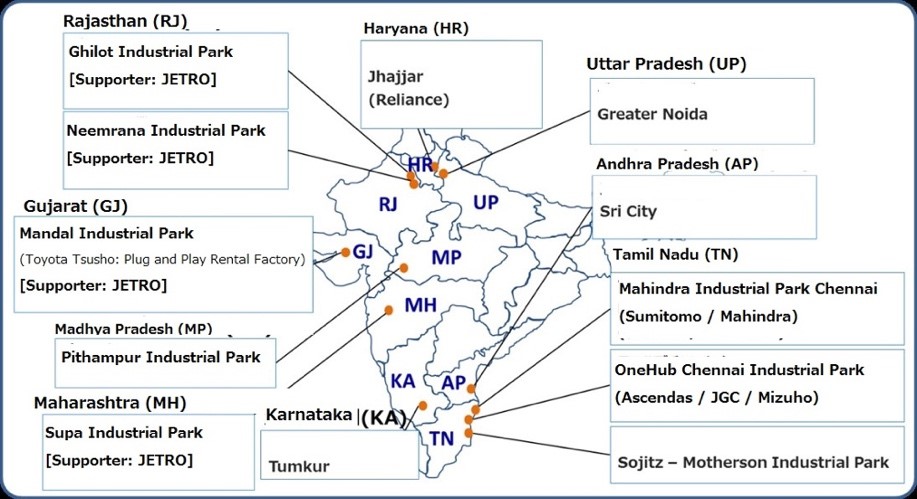
Source:
- DPIIT & Japan’s METI review progress under Japanese Industrial Townships in India
- Japan and India Exchange Progress Reports of Japan Industrial Townships in India
Image source:
Phensedyl smuggling
- Context: Phensedyl smuggling has been posing a big challenge for the Border Security Force (BSF).
- Phensedyl is a codeine-based cough syrup that is used in the treatment of dry cough.
- Codeine is used to relieve mild to moderate pain. It belongs to the group of medicines called narcotic analgesics (pain medicines). This medicine acts on the central nervous system (CNS) to relieve pain.
- Codeine is one of the natural plant alkaloids found in extracts of opium.
- Cough syrups with codeine phosphate are an easy way for people to get high and thus smuggled as drugs.
- A bottle of Phensedyl costs about ₹200 in India and the moment it crosses the border, the price goes up to thousands.
- In 2021, the South Bengal Frontier of the BSF had seized about 1.64 lakh bottles of Phensedyl along the border.

Source:
Picture source:
What RBI needs to keep in mind for a new digital currency: IE
Essence: Pursuant to the proposal in Union Budget, RBI is expected to introduce a digital currency in the coming financial year. Before full-fledged introduction, there are many questions related to conceptual issues which RBI will have to ask itself. Some of the issues to be analyzed include whether to go for a distributed ledger or centralized system, should digital currency be account based or token based and how to determine the supply of CBDC. Some have also argued that as a CBDC is a liability of the central bank and not commercial banks, it will minimize the depositors’ exposure to their bank.
There are advantages and disadvantages associated with each of such choices. The author suggests that in formulating its views on digital currencies, the RBI should simply be guided by the desire to preserve its monetary sovereignty. What RBI will choose will determine the form, functionality and ultimately the utility of the digital rupee in India.
Why should you read this article?
- To understand various policy choices RBI must make before launching digital currency.
- To understand the pros and cons of these choices.
Source:
Structural problems ail deputation of IAS officers: FE
Essence: Recent changes in cadre rules related to deputation of All India services has re-started an old debate on the issue. Sharing of All India Services between Union and state is an important feature of Indian political design. Cadre management, and the very concept of the All-India Services, has three objectives—ensure availability of adequate number of officers for both centre and states, ensure the federal character of the service by sending officers to states other than their own and ensure that the group of officers constituting the service are competent and capable to help provide good and effective governance in both the Centre and the states.
In recent years, many factors like lack of enough all-India services officers and politicization of center state relations, led to breakdown in the earlier smooth process of deputation to center. The article suggests measures like increase in direct recruitment annually and remove the artificial distinction between promotion and empanelment. The All-India Services are in the nature of sinews which uphold the federal structure and should not be weakened.
Why should you read this article?
- To understand the rationale behind establishment of All India services.
- To understand the genesis of tussle between Union and state over deputation.
- To under the measures needed for reforming All India Service
Source:
The Strategic Positioning of Climate Negotiations: HT
Essence: The editorial points towards the highlights of the present world, which has put the focus on large developing countries in enabling the mitigation of climate change. Politics has had its role to play. The developed world has pushed focus on developing countries which was seen in critics pointing at India’s “phase down” of coal at COP26 as a retrograde move. The author points to the fact that India consumes 5 times less coal energy per capita with respect to China and at least 2 times less as compared to USA and calls such global stance as diplomatic duplicity.
The principle of common but differentiated responsibility is the key for inclusive participation. This needs finances, technology, emission negotiations and trading, and diplomacy. Increased collaborations between non-G-7, yet G-20 members would be the lead to successful COP27 and COP28 scheduled at Sharm-el-Sheikh in Egypt and UAE respectively.
Why should you read this article?
- To understand the international politics around climate change.
- To know why developing countries need to participate rigorously in global climate negotiations.
Source:
Ganga Ghat as Gurukul
Background
- Education plays a vital role in our lives, as it improves knowledge, way of living as well as social and economic status of person.
- Nitin Kumar, from Kanpur, started the initiative to provide free coaching to students from the low income groups on the Ganga ghat.
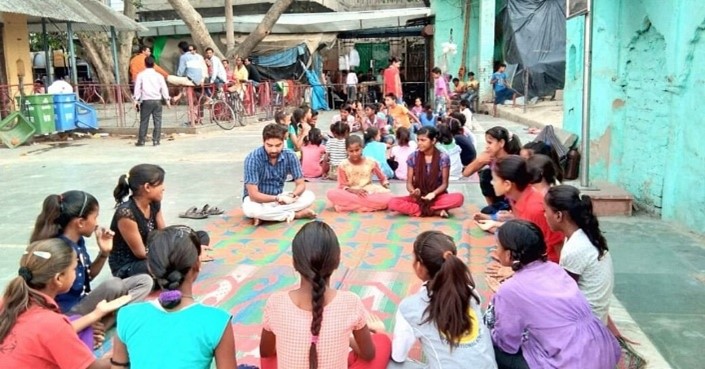
How did Ganga Ghat transform into Gurukul?
- Nitin realised the importance of education very early in his life, as his mother struggled to make ends meet through meagre income and his brother quit school to support the family financially.
- After completing his class 10 studies, Nitin started offering free tuition to kids from slum areas, as he believes that education could help several children like him gain financial agency.
- He also raises fund for the school fees and other expenses of the students of this coaching centre.
- Currently he is pursing law, and is in the a final year of the course.
- His NGO Ek Nayee Raah Foundation is working on the Kamleshwar Ghat along the Ganga River offering free coaching to almost 200 students.
Quote: “Education is the most powerful weapon which you can use to change the world” – Nelson Mandela
Source:
Share the article
Get Latest Updates on Offers, Event dates, and free Mentorship sessions.

Get in touch with our Expert Academic Counsellors 👋
FAQs
UPSC Daily Current Affairs focuses on learning current events on a daily basis. An aspirant needs to study regular and updated information about current events, news, and relevant topics that are important for UPSC aspirants. It covers national and international affairs, government policies, socio-economic issues, science and technology advancements, and more.
UPSC Daily Current Affairs provides aspirants with a concise and comprehensive overview of the latest happenings and developments across various fields. It helps aspirants stay updated with current affairs and provides them with valuable insights and analysis, which are essential for answering questions in the UPSC examinations. It enhances their knowledge, analytical skills, and ability to connect current affairs with the UPSC syllabus.
UPSC Daily Current Affairs covers a wide range of topics, including politics, economics, science and technology, environment, social issues, governance, international relations, and more. It offers news summaries, in-depth analyses, editorials, opinion pieces, and relevant study materials. It also provides practice questions and quizzes to help aspirants test their understanding of current affairs.
Edukemy's UPSC Daily Current Affairs can be accessed through:
- UPSC Daily Current Affairs can be accessed through Current Affairs tab at the top of the Main Page of Edukemy.
- Edukemy Mobile app: The Daily Current Affairs can also be access through Edukemy Mobile App.
- Social media: Follow Edukemy’s official social media accounts or pages that provide UPSC Daily Current Affairs updates, including Facebook, Twitter, or Telegram channels.

